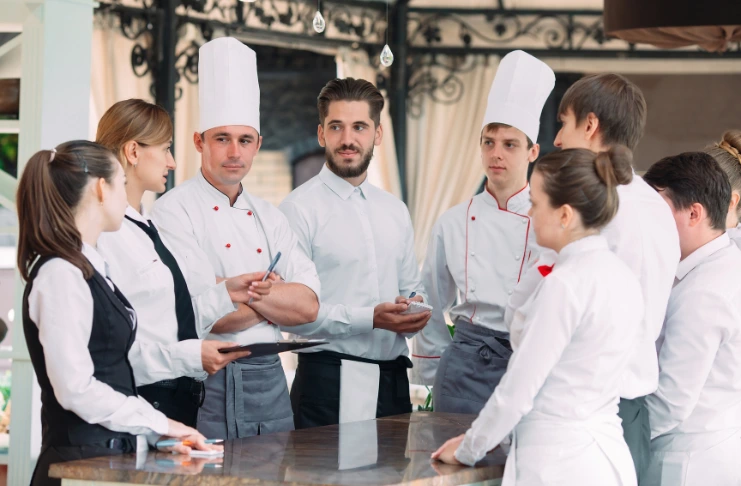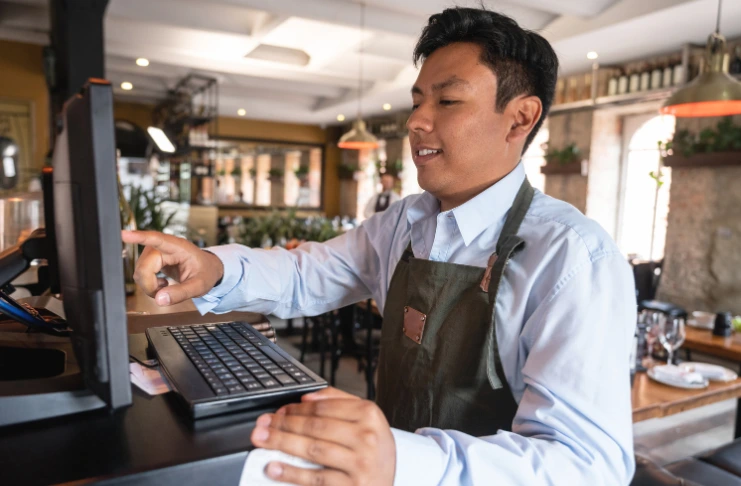
Imagine walking into a restaurant where every detail feels like it was created just for you—the warm greeting at the door, the perfectly timed service, the mouthwatering dishes, and an ambiance that makes you want to linger. Now imagine the opposite: a cold welcome, long wait times, and an underwhelming meal. Which restaurant are you more likely to rave about or revisit? This is the power of customer experience—it can make or break a restaurant. In an industry where fierce competition and customer expectations constantly evolve, delivering an unforgettable experience is the ultimate secret weapon for success.
Great customer experiences don’t just make diners happy; they turn them into loyal advocates who spread the word far and wide. A satisfied customer is your restaurant business’ best marketing tool, driving repeat business and bringing in new guests through glowing reviews and recommendations. This blog is your go-to guide for elevating your restaurant’s customer experience with actionable tips and proven strategies. Whether personalizing your service, using technology to streamline operations, or creating a memorable ambiance, you’ll learn how to transform every visit into a moment worth sharing—and keep your tables full.
Tips to Enhance Customer Experience
Train Your Staff

Your staff is the heart of your restaurant’s customer experience. Well-trained employees who excel in customer service can turn a good dining experience into an exceptional one. Customer service training is not just about teaching employees the basics of taking orders and serving food; it’s about instilling a hospitality mindset. Staff members should understand the importance of creating a welcoming atmosphere, responding to guest needs proactively, and leaving customers with a lasting positive impression. Small gestures can make all the difference, whether it’s a warm smile at the door or attentiveness during the meal.
Building a customer-focused team begins with clearly communicating your restaurant’s values and service standards. Regular training sessions, role-playing scenarios, and real-time feedback can help staff confidently navigate various customer interactions and situations.
Create an Exceptional First Impression
First impressions are crucial in the restaurant industry, setting the tone for the dining experience. A well-thought-out restaurant layout and ambiance are vital in making guests feel comfortable and welcome. Seating arrangements should be spacious and ergonomic, ensuring customers don’t feel cramped or uncomfortable. Lighting should align with the restaurant’s theme—soft, warm lights create a cozy atmosphere in fine dining restaurants, while bright, energetic lighting works well for casual or fast-casual settings. Music is equally important; it should complement the restaurant’s vibe without overpowering conversations. The right balance of these elements makes guests feel at ease and enhances their overall experience.
Beyond the physical setting, a warm and friendly greeting from the restaurant owner, host, or staff can significantly impact customer satisfaction. A simple smile, direct eye contact, and a genuine “Welcome! We’re happy to have you here” can go a long way in making guests feel valued. Staff should be trained to communicate clearly and confidently, providing accurate wait times, seating options, and recommendations if needed. If there’s a waitlist, offering water or a small appetizer can make the experience more pleasant.
Additionally, efficient wait time management is key to minimizing frustration. Many diners value their time, and long wait times can lead to negative reviews or lost business. Implementing a digital reservation system helps streamline bookings and prevent overcrowding. For walk-in customers, provide real-time updates, allowing guests to wait elsewhere without worrying about losing their spot. Restaurants that proactively manage wait times and communicate delays with transparency demonstrate respect for their customers’ time, ultimately leading to a more upbeat dining experience.
Streamline Operations
Operational efficiency is just as crucial as excellent service when it comes to delivering a seamless customer experience. Long wait times, delayed orders, and billing hiccups are some of the quickest ways to frustrate diners. Streamlining operations can reduce wait times and improve table turnover while allowing customers to enjoy their meals at a relaxed pace. Start by analyzing your restaurant’s workflows and identifying bottlenecks, whether in the kitchen, order-taking process, or table management. Simple adjustments, like organizing kitchen stations or improving communication between front- and back-of-house staff, can make a significant impact and increase customer satisfaction.
Technology plays a pivotal role in operational efficiency. Implementing a robust POS (Point of Sale) system can help streamline order management, reduce errors, and speed up payments. Modern POS systems also integrate with online reservations and mobile ordering, giving your customers more control over their experience. Additionally, using tools like digital table management systems can optimize seating arrangements and ensure smooth service during busy hours.
Menu Design and Innovative Dining Concepts

A well-designed menu is more than a list of dishes; it’s a powerful tool to guide customer choices and enhance guest satisfaction with their overall dining experience. A clear and visually appealing menu makes it easy for customers to navigate options, while strategically highlighting specials or chef-recommended dishes can encourage them to explore signature items. Beyond aesthetics, catering to dietary preferences and restrictions—such as vegetarian, gluten-free, or allergen-friendly options—ensures inclusivity and shows customers that their needs matter. Pairing thoughtful menu design with innovative dining concepts can elevate the experience further. By combining thoughtful menu design with creative touches, you can leave a lasting impression that encourages repeat visits and glowing recommendations.
Role of Technology in Enhancing Customer Experience

Technology has transformed how restaurants deliver customer experiences, making it easier and more convenient for diners. Online reservation systems allow customers to book tables quickly without the need for phone calls, while QR code menus provide an interactive way to view dishes, complete with photos and allergen information. Self-ordering kiosks are becoming popular in quick-service restaurants, giving customers a faster and more personalized ordering experience. Contactless payments and mobile payment options have also become essential, offering convenience and safety for guests, especially in a post-pandemic world.
New technologies are taking things even further. AI-powered chatbots on websites or mobile apps can answer customer queries instantly, like menu details or reservation help. Restaurants are using data to create personalized offers based on dining habits, making customers feel valued. Augmented reality (AR) menus let diners see 3D images of dishes before ordering, adding excitement to the experience. Tools like smart kitchen devices and real-time table management systems help restaurants run smoothly and minimize wait times. By adopting these technologies, restaurants can offer a smoother, more enjoyable experience that keeps customers coming back.
Create Memorable Experiences
Dining out is more than just eating—it’s about the experience, the emotions it evokes, and the memories it creates. To stand out in today’s competitive restaurant industry, you need to offer something beyond just great food. One way to do this is by introducing unique dining concepts that captivate and engage customers. Themed nights, such as a “Taco Tuesday” special or an “Italian Wine & Dine” evening, can create excitement and anticipation, encouraging repeat visits. Open kitchens add an element of transparency and theater to the dining experience, allowing guests to watch skilled chefs craft their meals in real time. Chef’s specials, tasting menus, or interactive experiences—such as build-your-own pizza or sushi-making classes—add a fun and personalized touch to a restaurant visit, making it more than just another meal.
Beyond structured events, small yet meaningful gestures can leave a lasting impression on your customers. Complimentary drinks or desserts for special occasions like birthdays or anniversaries show that you value and celebrate your guests. Personalized thank-you notes, either handwritten or digitally sent to loyal customers, create a warm and personal connection that keeps people coming back. These thoughtful touches not only enhance the overall dining experience but also encourage word-of-mouth recommendations, helping to build a strong and loyal customer base.
Expert Opinion:
Bob Vergidis, Chief Vision Officer at PointofSale.cloud, is a leading expert in restaurant technology and innovation. With years of experience shaping digital transformation within the food service industry, he specializes in helping restaurants leverage cutting-edge technology to enhance operations, increase efficiency, and improve customer engagement. His insights align perfectly with the evolving landscape of restaurant customer experience, where guest loyalty and personalization are becoming the key drivers of success:
“Guest loyalty will be a key trend in 2025. Restaurants are discovering that the best way to increase guest frequency is by understanding their preferences better. Technology will play a significant role as advanced software solutions become more accessible and restaurants increasingly adopt data-driven strategies. Artificial intelligence (AI) will continue to shape the industry, influencing every aspect of restaurant operations. From front-end tasks like order taking to back-of-house functions such as recipe development, cost management, and operational decision-making, AI will be an essential tool for restaurant success”.
Handling Customer Complaints & Feedback Effectively

Customer complaints are inevitable in the restaurant industry, but how they are handled can make or break a restaurant’s reputation. Proactive issue resolution is key—staff should be trained to address concerns immediately and professionally rather than allowing frustrations to escalate. Whether it’s an incorrect order, a delay in service, or dissatisfaction with food quality, a swift and sincere apology, followed by an immediate solution, can turn a negative experience into a positive one. Empowering employees to offer quick resolutions, such as a complimentary dish, a discount, or a sincere promise to rectify the issue, shows that the restaurant values its customers and their concerns. Moreover, management should always be accessible to step in when needed, ensuring that no complaint goes unresolved.
Beyond handling in-the-moment issues, encouraging honest feedback helps restaurants continuously improve customer service. Many customers hesitate to voice concerns in person but are willing to share feedback through surveys or online reviews. By treating complaints as opportunities for growth and ensuring customers feel heard, restaurants can build stronger relationships and foster long-term loyalty.
Examples of Restaurants Excelling in Customer Experience
Chick-fil-A: A Culture of Genuine Hospitality
Chick-fil-A consistently ranks among the top for customer satisfaction, reflecting its deep-rooted commitment to exceptional service. One of its hallmark practices is the use of “my pleasure” in response to customer thanks, showcasing genuine hospitality. This culture is reinforced through rigorous training and strong owner-operator involvement, ensuring hands-on management and a personalized customer experience at every location. Chick-fil-A’s dedication to service excellence fosters a welcoming environment that keeps customers returning.
Nobu: Excellence Through Team Cohesion and Innovation
Nobu, the globally acclaimed restaurant chain, thrives on a balance of high-quality cuisine, strategic locations, and a strong emphasis on team cohesion. Chef Nobuyuki “Nobu” Matsuhisa nurtures close relationships with staff, fostering a family-like culture and positive work environment that ensures high standards across over 50 locations worldwide. Regular training, internal promotions, and a shared vision contribute to staff loyalty and excellence. The brand’s innovative fusion of Japanese and Peruvian flavors and impeccable service create an unforgettable dining experience that resonates with guests.
Key Takeaways for Restaurants
- Cultivate a Strong Organizational Culture: A well-defined company ethos fosters consistency and customer trust.
- Invest in Comprehensive Staff Training: Well-trained employees enhance service quality and customer experience.
- Foster Close-Knit Team Relationships: A unified team creates a positive and cohesive dining environment.
- Prioritize Genuine Hospitality: Personalized interactions build lasting customer relationships.
- Embrace Innovation: Unique culinary offerings and efficient service models set restaurants apart in a competitive industry.
Conclusion
Creating an exceptional customer experience is a journey that requires consistent effort and a customer-first mindset. By implementing the actionable tips discussed—training staff to deliver outstanding service, streamlining operations for efficiency, designing an engaging and inclusive menu, and leveraging modern technologies—you can transform your restaurant into a space that customers love to visit and recommend. Prioritizing customer experience is more than just good business; it’s the key to building loyalty, fostering positive word-of-mouth, and achieving sustainable success in an increasingly competitive industry. Now is the time to act—evaluate your current processes, identify areas for improvement, and start making changes today. A better customer experience doesn’t just happen; it’s created, and your efforts can make all the difference.
Focusing on excellent service, efficient operations, and a welcoming ambiance can improve the restaurant’s customer experience. Investing in staff training, using technology to streamline ordering and payments, and offering personalized touches like loyalty programs or special offers can also significantly enhance customer satisfaction.
To improve customer experience, prioritize friendly and attentive service, maintain food consistency, and minimize wait times. Implementing modern tools like online ordering and reservations, digital menus, and customer feedback systems can help optimize operations and make dining more convenient and enjoyable.
To improve your restaurant experience, focus on hospitality and train warm, responsive, and knowledgeable staff. Enhance your ambiance with thoughtful lighting, comfortable seating, and engaging decor. Ensure your menu caters to diverse dietary preferences and offers creative, memorable dishes.
Enhancing guest experience involves creating a seamless journey from reservation to checkout. Offering unique dining experiences like chef’s specials, themed nights, or interactive elements—along with small personal touches such as complimentary treats or thank-you notes—can make guests feel valued and eager to return.








